Recognizing Sugar Beet Vs Sugar Cane: Secret Differences and Their Importance in the Worldwide Sugar Sector
The distinctions between sugar beet and sugar cane are substantial in the context of the worldwide sugar sector. Their varying weather demands influence where they can be cultivated, while their one-of-a-kind nutritional profiles impact consumer preferences. Furthermore, the financial implications of each crop shape market dynamics. Understanding these differences is essential for understanding the wider effect on production and supply chains. What further complexities develop when considering their roles in the market?
Climate and Geographic Versatility
Sugar beet and sugar cane display unique climate and geographical versatility that influences their growing. Sugar beet thrives in warm climates, needing great weather for excellent development. It is primarily expanded in areas such as Europe and The United States And Canada, where conditions prefer its growth during springtime and loss. On the other hand, sugar cane embellishments in exotic and subtropical climates, necessitating warm temperatures and abundant rains. This plant is chiefly cultivated in countries like Brazil, India, and Australia, where the environment sustains its long development cycle.The differing versatility of these crops affects not just their geographical distribution however likewise the agricultural practices employed by farmers. Sugar beet's durability to colder temperatures enables earlier planting, while sugar cane counts on a much longer growing period to attain maximum yield. Comprehending these climatic preferences is essential for improving manufacturing and making sure food safety and security in areas reliant on these critical sugar resources.
Cultivation and Gathering Methods

Growing sugar beet and sugar cane entails unique methods tailored per plant's certain development needs. Sugar beet is usually planted in cool, pleasant climates, calling for well-drained soil and precise spacing to enable optimal root growth. Sugar beet vs sugar cane. Farmers often employ mechanical planters to guarantee consistent seed positioning, followed by normal watering and weed monitoring practices to support growth.In comparison, sugar cane flourishes in warmer climates and is generally circulated through stem cuttings instead than seeds. Planting occurs in rows, permitting adequate sunlight and air flow. Collecting sugar cane is labor-intensive, typically including hand-operated cutting or using specialized equipment, relying on the scale of manufacturing. Conversely, sugar beet harvesting employs mechanical harvesters that extract the origins from the dirt, decreasing damages and ensuring a cleaner product. Both plants demand cautious management to take full advantage of return and quality, reflecting their relevance in the worldwide sugar market
Handling Techniques and Effectiveness
Handling techniques for sugar beet and sugar cane reveal vital differences that influence performance and yield. Sugar beetroots undergo a collection of steps, beginning with cutting the root into slim cossettes, adhered to by removal of juice with diffusion or pushing. This juice is then purified, focused, and taken shape, leading to granulated sugar. The procedure usually takes regarding 5-10 hours from collecting to crystallization.In contrast, sugar cane handling entails squashing the stalks to extract juice, which is after that heated up and clarified. The juice undertakes evaporation and formation, typically taking much longer than beet handling as a result of the coarse nature of the cane. In addition, sugar cane can be processed continually, enhancing effectiveness.
Economic Impact and International Production Patterns
The differences in handling approaches in between sugar beet and sugar cane not just influence efficiency but likewise have substantial economic ramifications. Sugar cane dominates in tropical regions, supplying reduced production expenses as a result of beneficial climatic conditions and reduced power demands. On the other hand, sugar beet is mainly grown in pleasant areas, where greater production prices are often sustained. This geographical disparity influences worldwide supply chains, influencing prices structures and availability.Recent patterns suggest a varying worldwide demand for sugar, with both plants experiencing price volatility. As nations go for self-sufficiency, investments in local sugar beet manufacturing have enhanced, especially in Europe and North America. At the same time, developing nations continue to depend greatly check out here on sugar cane, driven by export capacity. On the whole, the economic impact of these crops is extensive, shaping farming plans, profession agreements, their explanation and the sustainability of the worldwide sugar sector.
Nutritional Profiles and Health Considerations
While both sugar beet and sugar cane offer as main sources of sucrose, their dietary profiles and health and wellness factors to consider differ considerably. Sugar cane, usually viewed as a much more natural sugar, has trace amounts of vitamins and minerals, including calcium and potassium, along with anti-oxidants. In comparison, sugar beet is primarily made up of sucrose with marginal dietary value, but it is rich in fiber and specific phytonutrients, which may supply digestive benefits.Health considerations bordering both sources focus on their high glycemic index and potential effects for obesity and diabetic issues. While both kinds of sugar add to calorie consumption, the processing approaches can influence their health influence. Sugar beet usually goes through comprehensive refining, while sugar cane may retain more of its natural substances in much less processed forms, such as raw cane sugar. Inevitably, small amounts is key when including either right into a balanced diet.
Often Asked Concerns

Which Areas Mainly Expand Sugar Beet Versus Sugar Cane?
Areas primarily expanding sugar beet consist of Europe and The United States and Canada, while sugar cane thrives in tropical and subtropical locations such as Brazil, India, and Southeast Asia. Climate and dirt conditions greatly affect these farming patterns.
Exactly How Do Sugar Beet and Sugar Cane Differ in Preference?

What Are Usual Byproducts of Sugar Beet and Sugar Cane?
Usual byproducts of sugar beet include molasses and pet feed, while sugar cane returns bagasse, molasses, and ethanol. Both plants add considerably to various markets, enhancing sustainability and financial value beyond their primary sugar production.
How Do Environmental Variables Influence Sugar Beet and Sugar Cane Yields?

What Is the Historic Value of Sugar Beet and Sugar Cane Growing?
The historical significance of here are the findings sugar beet and sugar cane farming hinges on their duties in worldwide economies, farming techniques, and trade. Both plants shaped social frameworks, influenced early american plans, and added to the advancement of contemporary markets.
Comments on “What makes sugar beet vs sugar cane distinct in global sugar supply chains?”